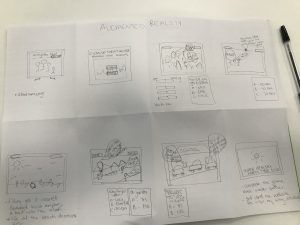We have been creating our prototype over the last couple of weeks and are now almost at the stage for it to be tested by our client. We have developed our prototype using the online software Marvel. It was fairly easy to use but proved a little more difficult when it came to linking the pages of the prototype together, as some of the questions we have decided to use have a number of different answer options, each of which needed their own individual page.
We also have prepared a list of questions to ask the client during the user testing. These will include what they liked/disliked about the prototype; if they found it easy to navigate and use; if there was anything that they would change etc. We realise now that when we undertake the user testing with the clients, the prototype doesn’t have to be a fully functioning product at this stage of the development process. Furthermore, it doesn’t matter whether they like everything about it because it’s not a finished product yet therefore again it will be useful to gather feedback to improve our prototype.
When it comes to the meeting whereby the client will test the prototype, we need to make sure they receive a friendly welcome to ensure we build a rapport with the users, especially in our case, as not all the team have met the clients before. We need to ensure that we create a friendly environment as the clients we are working with include children of secondary school age, therefore it’s very important that we make them feel relaxed and at ease to be able to be honest and critical of the prototype. This will make it easier to gain feedback and make improvements that they feel will be beneficial to the prototype.
During the user testing we needed to decide what aspects of the website we would test. We’ve decided to only test the game element within our website. We have chosen to do this because it’s the main part of our product and testing all elements would have been unrealistic as we wouldn’t have had enough time to prototype them all. Therefore the blog, events and newsfeed elements of the website will just be explained to the clients before we begin the user testing with them. We will discuss these other elements with them to make sure that they understand what we envision to include within these other aspects of the website. This includes uploading their own events for the community on the ‘Events’ section of the website.
The user testing will allow us to see how the client uses the prototype and to collect useful feedback about what works and what doesn’t in their opinion. It will also give us the opportunity to collect any ideas the client may have of what we could improve at this stage of development. This in turn will enable us to make alterations to the prototype before we present out final version of it to the client in a few weeks’ time.
